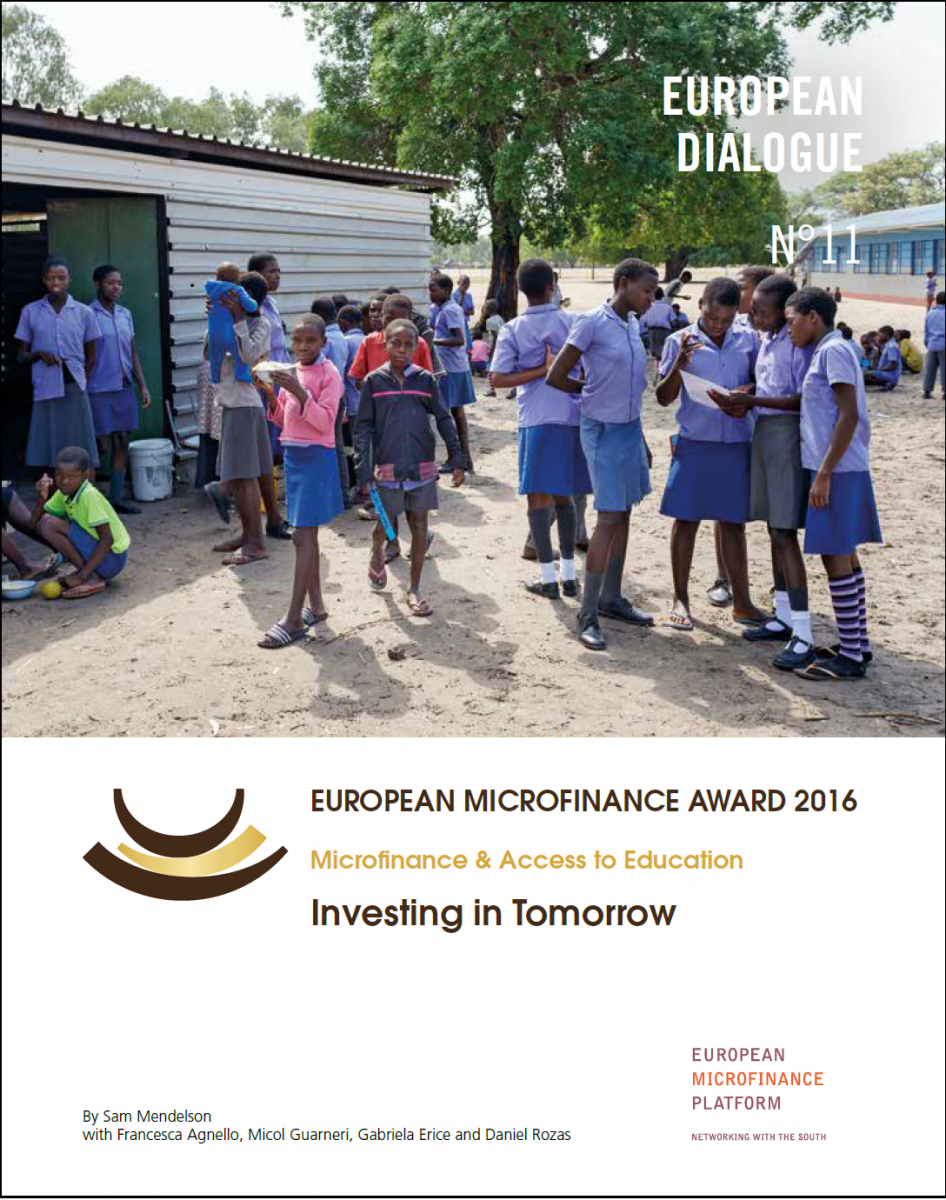 The European Microfinance Award 2016 addressed how the microfinance sector can increase access to education among children and young adults in low-income communities. Won by Kashf Foundation of Pakistan and presented at a ceremony in November during European Microfinance Week, the Award received applications from 19 countries, showing a broad range of interventions by MFIs to help increase access to education.
The European Microfinance Award 2016 addressed how the microfinance sector can increase access to education among children and young adults in low-income communities. Won by Kashf Foundation of Pakistan and presented at a ceremony in November during European Microfinance Week, the Award received applications from 19 countries, showing a broad range of interventions by MFIs to help increase access to education.
As in previous years, all the semi-finalists’ outstanding interventions have been profiled in a European Dialogue publication, entitled Investing in Tomorrow, written by Sam Mendelson, with support from Micol Guarneri, Francesca Agnello – the consultants who oversaw the Award application and analysis – and Gabriela Erice and Daniel Rozas from e-MFP. It can be read online here and downloaded as a PDF here.
The European Microfinance Award is one of e-MFP’s most prominent activities. A prestigious annual €100,000 Award which attracts applications from financial institutions around the world, it serves two parallel goals: rewarding excellence, and collecting and disseminating the most relevant practices for replication by others. This second goal is where Investing in Tomorrow comes in – describing the challenges facing MFIs, the types of interventions that can increase access to education, practical case study examples of the finalists and semi-finalists – organisations which put these models into practice – and what these excellent initiatives have in common.
Investing in Tomorrow opens by summarising the obstacles to access to education in low-income countries and outlines how microfinance institutions can work on either the supply or demand side to address these obstacles, with both financial and non-financial services. Financial services – loans, savings, insurance, payments – to families can enable them to pay for the costs of education, from kids going to primary school to youth seeking to build their future through further or tertiary education or by mastering the vocational skills needed to becoming productive adults.
Support to schools, such as capacity-building to the ubiquitous low cost private schools catering to millions of poor families in developing countries around the world, can substantially improve both the availability and quality of education. Vocational training or entrepreneurship programs for young adults can also address the skills gap that is widespread in many markets.
Investing in Tomorrow illustrates the broad range of interventions that MFIs are implementing to improve education access, and the absence of a one-size-fits-all solution. But while there is no single approach emerging, there is an emerging Best Practice – a collection of commonalities among all the best initiatives, which is the subject of the concluding section of the Dialogue.
The Award semi-finalists and finalists did not all demonstrate a standardised model but rather a range of different approaches, responsive to contexts that are particular to their countries, local markets, and clients. However, there were identifiable commonalities among those initiatives strong enough to have reached the semi-finalist stage or beyond.
First, almost all the education initiatives, rather than just offering financial or non-financial services, in fact offer both. There is a clear recognition that a holistic approach is by far the best. Credit is useful, but it is best combined with training, capacity building, counselling or community organising.
Second, several of the semi-finalists’ initiatives involved both demand- and supply-side interventions. This reflects a consensus that obstacles to quality education access seldom result just from families’ poverty, or schools’ poor infrastructure or teaching. The answer, as with many policy challenges, is complex, context-dependent, and requires an attack on multiple fronts.
Thirdly, it is clear that the best education initiatives, like the best microfinance products, are client-centric. The most successful responses to a challenge require a starting point of “what do the prospective beneficiaries of this initiative actually need?”
Fourth, the strongest initiatives all have a high level of embeddedness and institutional commitment. Education initiatives cannot be CSR budget line items. The semi-finalists all have strong buy-in from their management and governance teams, and high motivation to see the initiatives succeed.
Finally, almost all the semi-finalists recognise the importance of partnerships – whether with central or local government, education specialists, tertiary or technical institutions, NGOs, or funders. Education is never the core specialty of an MFI, and improving education access will require leveraging partnerships with those who specialise in education or are responsible for its provision.
We’re very pleased to once again publish a European Dialogue that can shine a bit more light on the phenomenal work that many MFIs are doing, and the ways that the focus of this industry continues to evolve beyond microcredit in innovative and exciting ways.
Read and download Investing in Tomorrow here.

Leave a comment